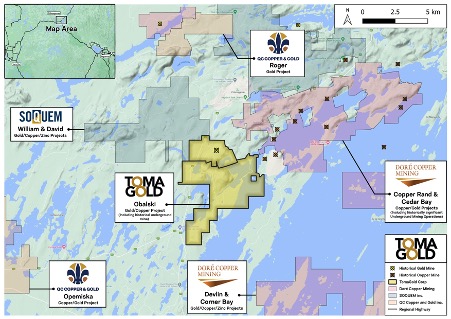TomaGold Corporation (TSXV: LOT) has received promising results from the year-end 2022 drilling programme on its wholly owned Obalski property in Quebec.
“While this latest programme has continued to intersect significant intersections on Obalski, we are particularly excited about the reanalysis results, which have increased certain historical gold grades significantly,” said David Grondin, President and CEO of TomaGold.
“After extensive testing by independent laboratories, we have concluded that the mineral material on Obalski needs to be grinded finer at 90% instead of 70% for optimal results and that the best results appear to come from lower grade intersections that do not have a nugget effect. To further confirm our theory, close to 300 samples from previous drilling were sent to the laboratory for reanalysis.”
Drilling programme
After a compilation of geophysical surveys carried out in several phases in 2021 and 2022 in the field and through drilling, several resistivity and chargeability anomalies were identified. Drilling recommendations were then submitted by Abitibi Geophysics of Val-d’Or.
Following these recommendations, a programme of six NQ diameter holes totalling 2,958m was drilled on high resistivity/low chargeability and low resistivity/high chargeability anomalies. Hole OBS-22-020 tested a high-resistivity anomaly and holes OBS-22-021 to OBS-22-025 tested two low-resistivity/high-chargeability anomalies.
The result obtained from hole OBS-22-025 is particularly significant. The hole intersected the A-Po mineralized zone at a vertical depth of 400m. This intersection could represent the A-Po zone which is intersected by a possible NNE-SSW trending fault that would have caused remobilization of the gold-bearing sulphides. This area will be the subject of further drilling.
Sample reanalysis
Since the acquisition of the Obalski project, several questions have been raised about the validity of the analytical methods used for gold and silver analysis. Some experts have raised the possibility of the presence of halogens while others have questioned the fineness of the initial grinding of the half-core samples and the final pulp volume upon pulverization.
The Corporation thus proceeded with the reanalysis of two groups of samples from significant mineralized zones. The first group was designed to investigate the possible presence of problematic halogens. A total of 44 pulp samples were processed by direct cyanidation. The results showed no significant difference between the fire assay and direct cyanidation methods. The halogen problem was therefore ruled out.
The second group of 132 samples was carefully selected for reprocessing from the original rejects. These rejects were reground to 90% passing 2.0mm instead of 70% passing 2.0 mm as was done in the first fire assay. The Corporation also decided to produce at least one kg of pulp at < 75 microns instead of 200g < 75 microns before the final 50 g batch for fire assay.
About 300 additional samples from previous drilling have been sent to the laboratory for reanalysis.
TomaGold will begin a 1,500m drill program on Obalski next week to test new targets identified by geophysics.
About the Obalski property
The Obalski property covers 345 hectares about 2km south of Chibougamau, Quebec. Discovered in 1928, the Obalski deposit produced 100,273t at grades of 1.14% Cu, 2.08g/t Au and 6.04g/t Ag from the A zone between 1964 and 1972, and around 9,000t at a reported grade of 8.5g/t Au from the D zone in 1984.
For further information please visit: https://www.tomagoldcorp.com












